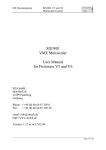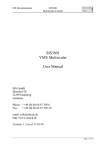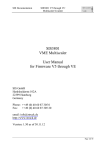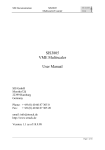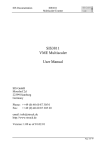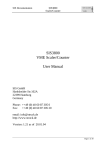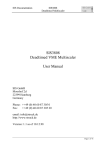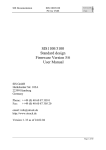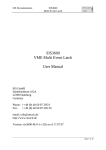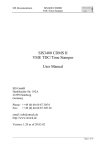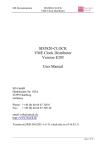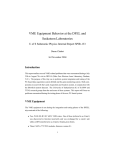Download SIS3610 VME Input/Output Register User Manual
Transcript
SIS Documentation SIS3610 Input/Output Register SIS3610 VME Input/Output Register User Manual SIS GmbH Harksheider Str. 102A 22399 Hamburg Germany Phone: ++49 (0) 40 60 87 305 0 Fax: ++49 (0) 40 60 87 305 20 email: [email protected] http://www.struck.de Version: 1.20 as of 02.08.06 sis3610-M-0-001v120 Page 1 of 34 SIS Documentation SIS3610 Input/Output Register Revision Table: Revision 0.10 0.20 0.21 1.00 1.01 1.02 1.10 1.11 1.20 Page 2 of 34 Date 27.07.02 20.11.02 22.11.02 13.12.02 20.01.03 05.03.03 02.11.04 04.01.06 02.08.06 Comment Generation from SIS3601 manual add JLAB/DUKE IRQ an Flipflop functionality Add or of control inputs as latch condition First official release Bug fix in address map IRQ setup sentence fix Firmware Version 2 for 50 Ω TTL units ESD note added Bug fix in input/output numbering SIS Documentation SIS3610 Input/Output Register 1 Table of contents 1 2 3 Table of contents............................................................................................................................................. 3 Introduction..................................................................................................................................................... 5 Technical Properties/Features ......................................................................................................................... 6 3.1 Board Layout........................................................................................................................................... 6 3.2 Design and Modus Operandi................................................................................................................... 7 4 Getting Started ................................................................................................................................................ 8 4.1 Factory Default Settings.......................................................................................................................... 8 4.1.1 Adressing ........................................................................................................................................ 8 4.1.2 System Reset Behaviour.................................................................................................................. 9 5 Firmware Selection ......................................................................................................................................... 9 5.1 Examples................................................................................................................................................. 9 Front Panel LEDs.................................................................................................................................................. 10 6 VME addressing............................................................................................................................................ 11 6.1 Address Space ....................................................................................................................................... 11 6.2 Base Address......................................................................................................................................... 11 6.2.1 VME.............................................................................................................................................. 11 6.2.2 VIPA/VME64x ............................................................................................................................. 11 6.3 Address Map ......................................................................................................................................... 12 7 Register Description...................................................................................................................................... 13 7.1 Status Register (0x0) ............................................................................................................................. 13 7.2 Control Register (0x0)........................................................................................................................... 14 7.2.1 Enable IRQ source/Interrupting .................................................................................................... 15 7.2.2 Flipflop enable .............................................................................................................................. 15 7.3 Module Identification register (0x4) ..................................................................................................... 16 7.4 Output data registers 0x8 and 0xC ........................................................................................................ 17 7.4.1 Direct output data register 0x8 ...................................................................................................... 17 7.4.2 J/K output data register 0xC.......................................................................................................... 18 7.5 Latched input data register 0x14 ........................................................................................................... 19 7.5.1 Latch strobe conditions ................................................................................................................. 19 7.6 Direct input data register 0x10 .............................................................................................................. 20 8 Input Configuration....................................................................................................................................... 21 9 Connector Specification ................................................................................................................................ 21 10 Control Signals.......................................................................................................................................... 21 10.1 Control Outputs..................................................................................................................................... 21 10.2 Control Inputs ....................................................................................................................................... 21 11 Signal timings ........................................................................................................................................... 22 12 Operating conditions ................................................................................................................................. 23 12.1 Power Consumption/Voltage requirement ............................................................................................ 23 12.2 Cooling.................................................................................................................................................. 23 12.3 Insertion/Removal ................................................................................................................................. 23 13 Test............................................................................................................................................................ 24 13.1 LED (selftest)........................................................................................................................................ 24 14 Software Support....................................................................................................................................... 24 14.1 Contents of the included CDROM ........................................................................................................ 24 15 Appendix................................................................................................................................................... 25 15.1 Address Modifier Overview.................................................................................................................. 25 15.2 Front Panel Layout................................................................................................................................ 26 15.3 List of Jumpers...................................................................................................................................... 27 15.4 Jumper and rotary switch locations ....................................................................................................... 27 15.4.1 Addressing mode and base address selection................................................................................ 27 15.4.2 J500 (Bootfile Selection) and J520 (SYSRESET Behaviour)....................................................... 28 15.5 Board Layout......................................................................................................................................... 29 15.6 Driver Piggy Pack Layout..................................................................................................................... 30 15.7 FLASHPROM Versions........................................................................................................................ 30 15.8 Row d and z Pin Assignments............................................................................................................... 31 15.9 Geographical Address Pin Assignments ............................................................................................... 32 15.10 Additional Information on VME....................................................................................................... 32 Page 3 of 34 SIS Documentation 16 SIS3610 Input/Output Register Index ......................................................................................................................................................... 33 Page 4 of 34 SIS Documentation SIS3610 Input/Output Register 2 Introduction The SIS3610 is a 16-bit input/16-bit output card on the base of the SIS36/38xx VME board family. It is a single width (4 TE) 6U (double euro form factor) card and combines part of the SIS3600 input register and SIS3601 output register functionality. The card was developed to act as a simple input/output module, which allows to set up to 16 output levels and to read up to 16 input levels in asynchronous slow control applications. Applications for the card comprise, but are not limited to: • read digital on/off status information (magnet, shutter, ...) • read 1-bit to 16-bit wide pattern • switch external hardware/flag status • write 1-bit to 16-bit wide pattern • interrupt generation • deadtime FLIPFLOP As we are aware, that no manual is perfect, we appreciate your feedback and will try to incorporate proposed changes and corrections as quickly as possible. The most recent version of this manual can be obtained by email from [email protected], the revision dates are online under http://www.struck.de/manuals.htm. A list of available firmware designs can be retrieved from http://www.struck.de/sis3638firm.htm Page 5 of 34 SIS Documentation SIS3610 Input/Output Register 3 Technical Properties/Features The SIS3610 is rather a firmware design in combination with given board stuffing options, than a name for the board (this is the reason, why the modules are named SIS36/38xx on the front panel and the distinction of the units is made by the module identifier register). The firmware makes use of part of the possibilities of the SIS36/38xx PCB, if the SIS3610 or other firmware designs of the family come close to what you need, but something is missing, a custom firmware design may be an option to consider. Find below a list of key features of the SIS3610. • 16-bit input • 16-bit output • 4 user outputs/flipflops (control section) • interrupt generation • common IRQ level up to 4 different IRQ vectors • NIM/TTL/ECL/LVDS versions • flat cable (TTL/ECL/LVDS) and LEMO (TTL/NIM) versions • A16/A24/A32 D16/D32 • Base address settable via 5 rotary switches (A32-A12) and one jumper (A11) • VIPA geographical addressing prepared • VIPA LED set • Up to eight firmware files • single supply (+5 V) 3.1 Board Layout Xilinx FPGAs are the working horses of the SIS36/38xx board series. The counter (prescaler, latch, ...) logic is implemented in one to four chips, each chip handles eight front end channels. The VME interface and the input and output control logic reside in two Xilinx chips also. The actual firmware is loaded into the FPGAs upon power up from a FLASHPROM under jumper control. The user can select among up to eight different boot files by the means of a 3-bit jumper array. The counter inputs, the control inputs and the outputs can be factory configured for ECL, LVDS, NIM and TTL levels. The front panel is available as flat cable (ECL, LVDS and TTL) or LEMO (NIM and TTL) version. The board layout is illustrated with the block diagram below: Page 6 of 34 SIS3610 Input/Output Register 4 4 4 4 4 4 4 4 Level Adaption Driver/Receiver Level Adaption Driver/Receiver Level Adaption Driver/Receiver Level Adaption Driver/Receiver Level Adaption Driver/Receiver Level Adaption Driver/Receiver Level Adaption Driver/Receiver Level Adaption Driver/Receiver 4 Level Adaption Driver/Receiver 4 Level Adaption Driver/Receiver Control XILINX VME Interface XILINX Frontend XILINX FLASH PROM Frontend XILINX File Selection VME Bus SIS Documentation Frontend XILINX Frontend XILINX SIS3610 Block Diagram 3.2 Design and Modus Operandi The inputs and outputs are implemented in XILINX FPGAs. One of the FPGAs holds 8 channels (bits). The data are passed to and read from the frontend chips by the control FPGA. The outputs are set by writing to the direct output data or the J/K output register, readback of the data is supported also. The inputs are read from the input data register. In addition the 4 user outputs can be controlled via the control register, they are implemented in a J/K fashion, what allows the user to change a single bit without knowledge of the status of the other three bits. Page 7 of 34 SIS Documentation SIS3610 Input/Output Register 4 Getting Started The minimum setup to operate the SIS3610 requires the following steps: • Check the proper firmware design is selected (should be design zero, i.e. all jumpers of jumper array J500 set. • Select the VME base address for the desired addressing mode • Select the VME SYSRESET behaviour via J520 • turn the VME crate power off • install the in/output register in the VME crate • connect your signals to the module • turn crate power back on • issue a key reset by writing to 0x60 • select latch strobe condition in control register • set outputs by writing to direct output data or J/K output register • read inputs by reading from the direct or latched input data register A good way of checking first time communication with the SIS3610 consists of switching on the user LED by a write to the control register at offset address 0x0 with data word 0x1 (the LED can be switched back off by writing 0x100 to the control register).. 4.1 Factory Default Settings 4.1.1 Adressing SIS3610 boards are shipped with the En_A32, the En_A24 and the En_A16 jumpers installed and the rotary switches set to: Switch Setting SW_A32U SW_A32L SW_A24U SW_A24L 3 8 3 8 SW_A16 3 J A_11 8 Bits 7-4 0 Bits 3-0 0 Jumper A_11 is open (bit 11 set). Hence the unit will respond to the following base addresses: Mode A32 A24 A16 Base address 0x38383800 0x383800 0x3800 Firmware Design Design 0 (SIS3610, Version 1) of the FLASHPROM is selected (all jumpers of jumper array J500 closed). Units with 50 Ω TTL levels are configured to boot design 1 (SIS3610, Version 2) for signal polarity reasons. 4.1.2 System Reset Behaviour J520 is set, i.e. the SIS3610 is reset upon VME reset. Page 8 of 34 SIS Documentation SIS3610 Input/Output Register 5 Firmware Selection The FLASH PROM of a SIS36/38xx board can contain several boot files. A list of available FLASHPROM versions can be found on our web site http://www.struck.de in the manuals page. If your FLASHPROM has more than one firmware design, you can select the desired firmware via the firmware selection jumper array J500 . You have to make sure, that the input/output configuration and FIFO configuration of your board are in compliance with the requirements of the selected firmware design (a base board without FIFO can not be operated as multi channel scaler e.g.). A total of 8 boot files from the FLASHPROM can be selected via the three bits of the jumper array. The array is located towards the rear of the card between the VME P1 and P2 connectors. The lowest bit sits towards the bottom of the card, a closed jumper represents a zero, an open jumper a one. 5.1 Examples The figures below show jumper array 500 with the soldering side of the board facing the user and the VME connectors pointing to the right hand side. Bootfile 0 selected With all jumpers closed boot file 0 is selected Bootfile 3 selected With the lowest two jumpers open bit 0 and bit 1 are set to 1 and hence boot file 3 is selected Page 9 of 34 SIS Documentation SIS3610 Input/Output Register Front Panel LEDs The SIS3610 has 8 front panel LEDs to visualise part of the units status. Three LEDs according to the VME64xP standard (Power, Access and Ready) plus 5 additional LEDs. Designation A P R U CLR OVL (CIP) S VU LED Access Power Ready VME user LED Out 4 Out 3 Out 2 Out 1 Color yellow red green green yellow red green green Function with SIS3610 design Signals VME access to the unit Flags presence of VME power Signals configured logic To be switched on/off under user program control Status of user output/Flipflop 4 Status of user output/Flipflop 3 Status of user output/Flipflop 2 Status of user output/Flipflop 1 The LED locations are shown in the portion of the front panel drawing below. The VME Access and the LNE LED are monostable (i.e. the duration of the on phase is stretched for better visibility), the other LEDs reflect the current status. An LED test cycle is performed upon power up (refer to chapter 13.1). Page 10 of 34 SIS Documentation SIS3610 Input/Output Register 6 VME addressing 6.1 Address Space As bit 11 is the lowest settable bit on the 36/38xx board, an address space of 2 Kbytes (Offset plus 0x000 to 0x7ff) is occupied by the module. 6.2 Base Address 6.2.1 VME The VME addressing mode (A16/A24/A32) is selected via the jumpers EN_A16, EN_A24 and EN_A32.The mode is selected by closing the corresponding jumper, it is possible to enable two or all three addressing modes simultaneously. The base address is set via the five rotary switches SW_A32U, SW_A32L, SW_A24U, SW_A24L and SW_A16 and the jumper J_A11. The table below lists the switches and jumpers and their corresponding address bits. Switch/Jumper SW_A32U SW_A32L SW_A24U SW_A24L SW_A16 J_A11 Affected Bits 31-28 27-24 23-20 19-16 15-12 11 In the table below you can see, which jumpers and switches are used for address decoding in the three different addressing modes (fields marked with an x are used). A32 A24 A16 SW_A32U x SW_A32L x SW_A24U x x SW_A24L x x SW_A16 x x x J_A11 x x x Note: J_A11 closed represents a 0, J_A11 open a one 6.2.2 VIPA/VME64x As the VME64x and the VME64xP (VIPA) standard were not yet standards to refer to and to declare conformity with at the point in time of the first SIS36/38xx firmware design developments, addressing modes (like geographical addressing e.g.) according to these standards are prepared but not yet implemented in the current firmware revisions. Page 11 of 34 SIS Documentation SIS3610 Input/Output Register 6.3 Address Map The SIS36/38xx boards are operated via VME registers, VME key addresses and the FIFO (where installed). The following table gives an overview on all SIS3610 addresses and their offset from the base address, a closer description of the registers and their function is given in the following subsections. Offset 0x000 0x004 0x008 0x00C 0x010 0x014 0x060 Key KA Access R/W R/W R/W R R R W Type D16/D32 D16/D32 D16/D32 D16/D32 D16/D32 D16/D32 D16/D32 Function Control and status register Module Identification register direct output data register J/K output data register direct input register latched input register reset register (global reset) Note: D08 is not supported by the SIS36/38xx boards The shorthand KA stands for key address. Write access with arbitrary data to a key address initiates the specified function Page 12 of 34 SIS Documentation SIS3610 Input/Output Register 7 Register Description 7.1 Status Register (0x0) The status register reflects the current settings of theSIS3610 parameters, which have been set in write access to the control register (which resides at offset 0 also). Bit 31 30 29 28 27 26 25 24 23 22 21 20 19 18 17 16 15 14 13 12 11 10 9 8 7 6 5 4 3 2 1 0 Function Status VME IRQ source 3 (control input 4) Status VME IRQ source 2 (control input 3) Status VME IRQ source 1 (control input 2) Status VME IRQ source 0 (control input 1) VME IRQ internal VME IRQ 0 0 Status VME IRQ Enable Bit source 3 (control input 4) Status VME IRQ Enable Bit source 2 (control input 3) Status VME IRQ Enable Bit source 1 (control input 2) Status VME IRQ Enable Bit source 0 (control input 1) Status Flipflop enable 4 Status Flipflop enable 3 Status Flipflop enable 2 Status Flipflop enable 1 0 0 0 0 0 0 0 0 Status user output 4 Status user output 3 Status user output 2 Status user output 1 Status latch strobe bit 1 Status latch strobe bit 0 Status interrupter style (0=RORA, 1=ROAK) Status user LED The reading of the status register after power up or key reset is 0x0 (see default settings of control register). Page 13 of 34 SIS Documentation SIS3610 Input/Output Register 7.2 Control Register (0x0) The control register allows the user to control the user LED and the user outputs of the SIS3610 board in write access. It is implemented via a selective J/K register, a specific function is enabled by writing a 1 into the set/enable bit, the function is disabled by writing a 1 into the clear/disable bit (which has a different location within the register). An undefined toggle status will result from setting both the enable and disable bits for a specific function at the same time. On read access the same register represents the status register. Bit 31 30 29 28 27 26 25 24 23 22 21 20 19 18 17 16 15 14 13 12 11 10 9 8 7 6 5 4 3 2 1 0 Function disable IRQ source 3 (control input 4) (*) disable IRQ source 2 (control input 3) (*) disable IRQ source 1 (control input 2) (*) disable IRQ source 0 (control input 1) (*) disable Flipflop 4 (*) disable Flipflop 3 (*) disable Flipflop 2 (*) disable Flipflop 1 (*) enable IRQ source 3 (control input 4) (*) enable IRQ source 2 (control input 3) (*) enable IRQ source 1 (control input 2) (*) enable IRQ source 0 (control input 1) (*) enable Flipflop 4 enable Flipflop 3 enable Flipflop 2 enable Flipflop 1 set user output 4 to 0 (*)/reset Flipflop 4 set user output 3 to 0 (*)/reset Flipflop 3 set user output 2 to 0 (*)/reset Flipflop 2 set user output 1 to 0 (*)/reset Flipflop 1 clear latch strobe bit 1 clear latch strobe bit 0 set RORA style interrupter/disable ROAK (*) switch off user LED and clear user output (*) set user output 4 to 1 set user output 3 to 1 set user output 2 to 1 set user output 1 to 1 set latch strobe bit 1 (0: leading edge of CTRL input 1, 1: change of input bit D0 ) set latch strobe bit 0 (1: enable leading edge of OR of control inputs 1-4) set ROAK style interrupter/disable RORA (*) switch on user LED and set user output (*) denotes the default power up or key reset state Page 14 of 34 SIS Documentation SIS3610 Input/Output Register 7.2.1 Enable IRQ source/Interrupting The four control inputs can be used for interrupt generation. Following steps are required to set up the SIS3610 as interrupt generating VME slave: • select RORA/ROAK interrupter style in control register • enable IRQ source (i.e. define which control inputs are active for input generation) • define interrupt level and interrupt vector in the module id. and IRQ control register and set the VME IRQ enable bit in the same register Note: The lowest four bits of the interrupt vector are defined by the status of the Flipflops and will allow for distinction between the control inputs if the OR condition is active. This will allow you to implement different readout types for up to four different trigger types by taking the corresponding action in your interrupt service routine. 7.2.2 Flipflop enable The control outputs of the SIS3610 can be operated as Flipflops. In Flipflop mode control output N is set with the leading edge of a signal on control input N and reset with the reset Flipflop N bit in the control register. Flipflop operation for output N is activated by setting the enable Flipflop N bit in the control register. The Flipflop logic is illustrated below. Note: Flipflop 1 is set by a level change of input data bit 0 if bit 3 of the control register is set to 1 (latch strobe condition bit change). This feature can be used to one or several frontend crates by incrementing a up to 16-bit wide event number with the output section of another SIS3610 (or a SIS3610 in event number increment mode) in a “master crate”. Control Input 2 ... 4 A N D Enable Flipflop 2 ... 4 O R VME Set Flipflop 2 ... 4 SET Q VME Clear CLR Control register bit 3 Input data D0 changed Control Input 1 Enable Flipflop 1 1 A N D 0 VME Set O R Flipflop 1 SET Q VME Clear CLR Page 15 of 34 SIS Documentation SIS3610 Input/Output Register 7.3 Module Identification register (0x4) This register has two basic functions. The first is to give information on the active firmware design. This function is implemented via the read only upper 20 bits of the register. Bits 1631 hold the four digits of the SIS module number (like 3801 or 3610 e.g.), bits 12-15 hold the version number. The version number allows a distinction between different implementations of the same module number, the SIS3801 for example has the 24-bit mode with user bits and the straight 32-bit mode as versions. The second function is the definition of the VME IRQ level and vector and activation of VME interrupt generation. Bit 31 30 29 28 27 26 25 24 23 22 21 20 19 18 17 16 15 14 13 12 11 10 9 8 7 6 5 4 3 2 1 0 Read/Write access read only read only read only read only read only read only read only read only read only read only read only read only read only read only read only read only read only read only read only read only read/write read/write read/write read/write read/write read/write read/write read/write read/write read/write read/write read/write Function Module Identification Bit 15 Module Id Digit 3 Module Identification Bit 14 Module Identification Bit 13 Module Identification Bit 12 Module Identification Bit 11 Module Id Digit 2 Module Identification Bit 10 Module Identification Bit 9 Module Identification Bit 8 Module Identification Bit 7 Module Id Digit 1 Module Identification Bit 6 Module Identification Bit 5 Module Identification Bit 4 Module Identification Bit 3 Module Id Digit 0 Module Identification Bit 2 Module Identification Bit 1 Module Identification Bit 0 Version Bit 3 Version Bit 2 Version Bit 1 Version Bit 0 VME IRQ enable flag (0=IRQ disabled, 1=IRQ enabled) VME IRQ Level Bit 2 VME IRQ Level Bit 1 VME IRQ Level Bit 0 IRQ Vector Bit 7; placed on D7 during VME IRQ ACK cycle IRQ Vector Bit 6; placed on D6 during VME IRQ ACK cycle IRQ Vector Bit 5; placed on D5 during VME IRQ ACK cycle IRQ Vector Bit 4; placed on D4 during VME IRQ ACK cycle IRQ Vector Bit 3; write with 0, read status FLIPFLOP 4 IRQ Vector Bit 2; write with 0, read status FLIPFLOP 3 IRQ Vector Bit 1; write with 0, read status FLIPFLOP 2 IRQ Vector Bit 0; write with 0, read status FLIPFLOP 1 Module identification and version example: The register for a SIS3801 in straight 32-bit mode (version 1) reads 0x38011nnn, for a SIS3801 in 24-bit mode (version 2) it reads 0x38012nnn. (the status of the lower 3 nibbles is denoted with n in the example with all n’s). Page 16 of 34 SIS Documentation SIS3610 Input/Output Register 7.4 Output data registers 0x8 and 0xC The output levels of the 16 outputs can be controlled by two registers • direct output data register (read/write) • J/K output register (write only) The level will be set according to the last transaction to both registers and can be read back from the direct output data register (even if it was altered by the J/K output register). While it is most straightforward to define a complete pattern like an event number with the direct output data register, the J/K register can be used to set/clear or flip an individual bit only without the hassle to remember the previous state. 7.4.1 Direct output data register 0x8 This read/write register defines the data which are applied to the output drivers. Bit 31 ... 16 15 14 13 12 11 10 9 8 7 6 5 4 3 2 1 0 Function unused read back as 0 ... unused read back as 0 Output Bit 15 Output Bit 14 Output Bit 13 Output Bit 12 Output Bit 11 Output Bit 10 Output Bit 9 Output Bit 8 Output Bit 7 Output Bit 6 Output Bit 5 Output Bit 4 Output Bit 3 Output Bit 2 Output Bit 1 Output Bit 0 The default state upon power up and key reset is 0x0, i.e. all outputs at 0 Page 17 of 34 SIS Documentation SIS3610 Input/Output Register 7.4.2 J/K output data register 0xC The second way to control the output level of SIS3610 is access to this write only register. It is implemented in a J/K fashion. Writing a 1 to the set bit (bits 0-15) will set the corresponding bit will result in a logic 1 on the output. Writing a 1 to the clear bit (bits 16-31) will clear the output level. Priority is on set if both set and clear are 1 at the same time. The current output pattern can be read back from the direct output register . Bit 31 30 29 28 27 26 25 24 23 22 21 20 19 18 17 16 Function Clear Output Bit 15 Clear Output Bit 14 Clear Output Bit 13 Clear Output Bit 12 Clear Output Bit 11 Clear Output Bit 10 Clear Output Bit 9 Clear Output Bit 8 Clear Output Bit 7 Clear Output Bit 6 Clear Output Bit 5 Clear Output Bit 4 Clear Output Bit 3 Clear Output Bit 2 Clear Output Bit 1 Clear Output Bit 0 15 14 13 12 11 10 9 8 7 6 5 4 3 2 1 0 Set Output Bit 15 Set Output Bit 14 Set Output Bit 13 Set Output Bit 12 Set Output Bit 11 Set Output Bit 10 Set Output Bit 9 Set Output Bit 8 Set Output Bit 7 Set Output Bit 6 Set Output Bit 5 Set Output Bit 4 Set Output Bit 3 Set Output Bit 2 Set Output Bit 1 Set Output Bit 0 Page 18 of 34 SIS Documentation SIS3610 Input/Output Register 7.5 Latched input data register 0x14 VME read access to this read only register returns previously latched data. The VME read cycle does not initiate a latch cycle (this functionality is covered by the direct input data register). Bit 31 ... 16 15 14 13 12 11 10 9 8 7 6 5 4 3 2 1 0 Function unused read back as 0 ... unused read back as 0 Input Bit 15 Input Bit 14 Input Bit 13 Input Bit 12 Input Bit 11 Input Bit 10 Input Bit 9 Input Bit 8 Input Bit 7 Input Bit 6 Input Bit 5 Input Bit 4 Input Bit 3 Input Bit 2 Input Bit 1 Input Bit 0 7.5.1 Latch strobe conditions The latch condition is defined qith bits 2 and 3 of the control register . as illustrated in the table below. Bit 3 0 0 1 1 Bit 2 0 1 0 1 Condition Leading edge of control input 1 Leading edge of OR of control inputs 1 to 4 not used Status change of input bit 0 not used It will depend on the nature of the application what strobe condition is adequate, examples are listed in the table below. Condition VME read access (read data from direct data register) Status change of input bit 0 (read data from latched data register) Leading edge of control input (read data from latched data register) Leading edge of OR of control inputs (read data from latched data register) Application example Asynchronous read of input status Distribution of 16-bit event number across several crates. Synchronous input status read upon external trigger Synchronous input status read upon different external triggers Page 19 of 34 SIS Documentation SIS3610 Input/Output Register 7.6 Direct input data register 0x10 VME read access to this read only register latches the current input levels that are present on the 16 inputs and returns the latched input data. Bit 31 ... 16 15 14 13 12 11 10 9 8 7 6 5 4 3 2 1 0 Function unused read back as 0 ... unused read back as 0 Input Bit 16 Input Bit 15 Input Bit 14 Input Bit 13 Input Bit 12 Input Bit 11 Input Bit 10 Input Bit 9 Input Bit 8 Input Bit 7 Input Bit 6 Input Bit 5 Input Bit 4 Input Bit 3 Input Bit 2 Input Bit 1 Page 20 of 34 SIS Documentation SIS3610 Input/Output Register 8 Input Configuration SIS36/38xx boards are available for NIM, TTL and ECL input levels and in LEMO and flat cable versions. The boards are factory configured for the specified input level and connector type, input termination is installed. 9 Connector Specification The four different types of front panel and VME connectors used on the SIS360x and SIS38xx boards are: Connector 160 pin zabcd 20 pin header 34 pin header LEMO Purpose VME P1/P2 Control (flat cable versions) Inputs (flat cable versions) Control and Input (LEMO versions) Part Number Harting 02 01 160 2101 DIN41651 20 Pin (AMP e.g.) DIN41651 34 Pin (AMP e.g.) LEMO ERN.00.250.CTL 10 Control Signals 10.1 Control Outputs Four control output signals are defined in the SIS3610 firmware design. Signal User Output/Flipflop 4 User Output/Flipflop 3 User Output/Flipflop 2 User Output/Flipflop 1 Control Signal 8 7 6 5 10.2 Control Inputs Four control input signals are defined in the SIS3610 firmware design. They can be used for interrupt generation and to set the Flipflop of the corresponding channel (to be reset by VME). Signal Control Input 4 Control Input 3 Control Input 2 Control Input 1 Control Signal 4 3 2 1 Page 21 of 34 SIS Documentation SIS3610 Input/Output Register 11 Signal timings Signal timings are sketched in the diagrams below. Data have to be stable for > 45 ns after the strobe by the corresponding control signal or > 60 ns after the bit change induced strobe by data bit 0. Strobe by control signal (NIM e.g.) Control 0 - 45 ns Data Strobe by data bit 0 change Data bit 0 Data < 40 ns > 60 ns Page 22 of 34 SIS Documentation SIS3610 Input/Output Register 12 Operating conditions 12.1 Power Consumption/Voltage requirement Although the SIS3610 is prepared for a number of VIPA features, an on board DC/DC converter is used to generate the –5 V, which are needed for driver and receiver chips, to allow for the use of the module in all 6U VME environments. The power consumption is <17,5 W (+5V, <3,5A). 12.2 Cooling Forced air flow is required for the operation of the SIS3610 board. 12.3 Insertion/Removal Please note, that the VME standard does not support live insertion (hot swap). Hence crate power has to be turned off for installation and removal of SIS3610 output registers. The leading pins on the SIS3610 VME64x VME connectors and connected on board circuitry are designed for hot swap in conjunction with a VME64x backplane (a VME64x backplane can be recognised by the 5 row VME connectors, while the standard VME backplane has three row connectors only). Page 23 of 34 SIS Documentation SIS3610 Input/Output Register 13 Test As the SIS3610 firmware is a rather simple design, it does not feature self test capabilities besides the power up self test of the module. 13.1 LED (selftest) During power up self test and LCA configuration all LEDs except the Ready (R) LED are on. After the initialisation phase is completed, all LEDs except the Ready (R) LED and the Power (P) have to go off. Differing behaviour indicates either a problem with the download of the firmware boot file or one or more LCA and/or the download logic. 14 Software Support VME boards are tested at SIS with an OR VP6 VME CPU (Pentium II based) under Windows 95 and a National Instruments CVI user interface. The actual VME C code makes use of the OR Windows 95 DLL. More recently testing of part of the modules is done with the SIS1100/3100 under LINUX or Windows2000/XP In many cases the user setup will be using different hardware, a full fledged real time operating system like VxWorks, and a different user interface. We still believe, that it is helpful to have a look at the code which is used to test the units and to take it as an example for the implementation of the actual readout application. A CDROM with our SIS36/38xx test software (which is used to test the unit for the time being) is enclosed with SIS3610 shipments to first time users. 14.1 Contents of the included CDROM Shipments to first time users are accompanied by the SIS36/38xx CDROM. The CDROM contains the PDF manuals for all modules of the family as well as test software for the modules for VP5/6/7 SBCs by SBS OR computers running under Windows 95. In addition C example code for the SIS1100/3100 PCI to VME interface for part of the modules is contained also. Page 24 of 34 SIS Documentation SIS3610 Input/Output Register 15 Appendix 15.1 Address Modifier Overview Find below the table of address modifiers, which can be used with the SIS36/38xx (with the corresponding addressing mode enabled). AM code 0x3F 0x3D 0x3B 0x39 0x2D 0x29 0x0F 0x0D 0x0B 0x09 Mode A24 supervisory block transfer (BLT) A24 supervisory data access A24 non-privileged block transfer (BLT) A24 non-privileged data access A16 supervisory access A16 non-privileged access A32 supervisory block transfer (BLT) A32 supervisory data access A32 non-privileged block transfer (BLT) A32 non privileged data access Future option: CBLT Page 25 of 34 SIS Documentation SIS3610 Input/Output Register 15.2 Front Panel Layout The front panel of the SIS3610 is equipped with 8 LEDs, 8 control in- and outputs and 16 inputs and 16 outputs. On flat cable units (ECL, LVDS and TTL) the control connector is a 20 pin header flat cable connector and the channel inputs are fed via two 34-pin headers. On LEMO (NIM and TTL) units the control in- and outputs are grouped to one 8 channel block and the inputs/outputs are grouped into 2 blocks of 16 channels. The outputs are on data channels 1-16 (i.e. lower connector), the inputs on data channels 17-32 (i.e. upper connector). The units are 4 TE (one VME slot) wide, the front panel is of EMC shielding type. VME64x extractor handles are available on request or can be retrofitted by the user, if he wants to change to a VME64x crate at a later point in time. In the drawing below you can find the flat cable (left hand side), the mixed (LEMO control, flat cable output, middle) and the LEMO (right) front panel layouts. Note: Only the aluminium portion without the extractor handle mounting fixtures is shown Page 26 of 34 SIS Documentation SIS3610 Input/Output Register 15.3 List of Jumpers Find below a list of the jumpers and jumper arrays. Jumper Name J101 J102 J103 J104 J105 J106 J107 J108 J115 J500 J520 EN_A16 EN_A24 EN_A32 J_A11 Array/Single Single Single Single Single Single Single Single Single Single Array Single Single Single Single Single Function Input Termination Control Input 1 Input Termination Control Input 2 Input Termination Control Input 3 Input Termination Control Input 4 Input Termination Control Input 5 Input Termination Control Input 6 Input Termination Control Input 7 Input Termination Control Input 8 Level Configuration (not for end user) Boot File Selection VME SYSRESET Behaviour Enable A16 addressing Enable A24 addressing Enable A32 addressing Address Bit 11 Selection 15.4 Jumper and rotary switch locations 15.4.1 Addressing mode and base address selection The EN_A32, EN_A24, EN_A16, A_11 and the 5 rotary switches are located int the middle of the upper section of the board close to the DC/DC converter, the corresponding section of the PCB is shown below. Page 27 of 34 SIS Documentation SIS3610 Input/Output Register 15.4.2 J500 (Bootfile Selection) and J520 (SYSRESET Behaviour) The jumper array J500 is located between the P1 and the P2 connector. An open position in J500 defines a one (see also chapter 4), the lowest bit is next to the P2 connector.. J520 is located to the left of J500 and closer to the DC-DC converter. With jumper J520 closed the SIS3801 executes a key reset upon the VME SYSRESET signal. The section of the board with the jumper array and the SYSRESET jumper is shown below. Page 28 of 34 SIS Documentation SIS3610 Input/Output Register 15.5 Board Layout Page 29 of 34 SIS Documentation SIS3610 Input/Output Register 15.6 Driver Piggy Pack Layout Driver piggy pack cards are installed on the two output groups of ECL and NIM level modules. Each of the cards drives 8 output bits. The top side of the driver card is shown below. 15.7 FLASHPROM Versions A list of available FLASHPROMs can be obtained from http://www.struck.de/sis3638firm.htm. Please note, that a special hardware configuration may be necessary for the firmware design of interest (the SIS3801 design requires the installation of a FIFO e.g.). The table on the web is of the format shown below: SIS36/38xx FLASHPROM table Design Name SIS3600_081298 SIS3800_201098 SIS3801_201098 SIS3610_181004 Page 30 of 34 Design 0 0 0 1 2 3 0 1 Boot File (s) SIS3600 Version 1 SIS3800 Version 1 SIS3800 Version 1 SIS3800 Version 2 SIS3801 Version 1 (32-bit Design) SIS3801 Version 2 (24-bit Design) SIS3610 Version 1 SIS3610 Version 2 SIS Documentation SIS3610 Input/Output Register 15.8 Row d and z Pin Assignments The SIS3610 is prepared for the use with VME64x and VME64xP backplanes. Foreseen features include geographical addressing and live insertion (hot swap). The prepared pins on the d and z rows of the P1 and P2 connectors are listed below. Position P1/J1 Row z 1 2 3 4 5 6 7 8 9 10 11 12 13 14 15 16 17 18 19 20 21 22 23 24 25 26 27 28 29 30 31 32 GND P2/J2 Row d VPC (1) GND (1) Row z GND GND GND GND GND GND GND RESP* GND Row d GND GAP* GA0* GA1* GND GND GA2* GND GND GA3* GND GND GA4* GND GND GND GND GND GND GND GND GND GND GND GND GND GND GND GND (1) VPC (1) GND GND (1) VPC (1) Note: Pins designated with (1) are so called MFBL (mate first-break last) pins on the installed 160 pin connectors, VPC(1) pins are connected via inductors. Page 31 of 34 SIS Documentation SIS3610 Input/Output Register 15.9 Geographical Address Pin Assignments The SIS38xx board series is prepared for geographical addressing via the geographical address pins GA0*, GA1*, GA2*, GA3*, GA4* and GAP*. The address pins are left open or tied to ground by the backplane as listed in the following table: Slot Number 1 2 3 4 5 6 7 8 9 10 11 12 13 14 15 16 17 18 19 20 21 GAP* Pin Open Open GND Open GND GND Open Open GND GND Open GND Open Open GND Open GND GND Open GND Open GA4* Pin Open Open Open Open Open Open Open Open Open Open Open Open Open Open Open GND GND GND GND GND GND GA3* Pin Open Open Open Open Open Open Open GND GND GND GND GND GND GND GND Open Open Open Open Open Open GA2* Pin Open Open Open GND GND GND GND Open Open Open Open GND GND GND GND Open Open Open Open GND GND GA1* Pin Open GND GND Open Open GND GND Open Open GND GND Open Open GND GND Open Open GND GND Open Open GA0* Pin GND Open GND Open GND Open GND Open GND Open GND Open GND Open GND Open GND Open GND Open GND 15.10 Additional Information on VME The VME bus has become a popular platform for many realtime applications over the last decade. Information on VME can be obtained in printed form, via the web or from newsgroups. Among the sources are the VMEbus handbook, http://www.vita.com (the home page of the VME international trade association (VITA)) and comp.bus.arch.vmebus. In addition you will find useful links on many high energy physics labs like CERN or FNAL Page 32 of 34 SIS Documentation SIS3610 Input/Output Register 16 Index 24-bit mode 16 32-bit mode 16 A_11 8, 27 A16 8 A24 8 A32 8 Address Map 12 Address Modifier Overview 25 address modifiers 25 Address Space 11 addressing A16, A24, A32 27 addressing mode 25 Addressing mode 27 addressing modes 11 Adressing 8 Base address 8 Base Address 11, 27 BLT 25 Board Layout 29 Boot File Selection 27 Bootfile Selection 28 CBLT 25 CDROM 24 CERN 32 Connector Specification 21 control inputs 21 outputs 21 Control and Status register 12 Control Input 27 Control Register 14 Control signals 21 Cooling 23 custom firmware 6 CVI 24 DC/DC converter 27 driver 30 ECL 30 En_A16 8 EN_A16 11, 27 En_A24 8 EN_A24 11, 27 En_A32 8 EN_A32 11, 27 Factory Default Settings 8 firmware design 8, 16 Firmware Design 8 Firmware Selection 9 Bootfile 9 Examples 9 FLASHPROM 6, 9 FLASHPROM Versions 30 flipflop 21 enable 15 FNAL 32 Front Panel LED 10 Front Panel Layout 26 GA0* 32 GA1* 32 GA2* 32 GA3* 32 GA4* 32 GAP* 32 geographical address pins 32 Geographical Address 32 geographical addressing 31 Getting Started 8 hot swap 23, 31 http //www.vita.com 32 Input Configuration 21 inputs control 21 Insertion/Removal 23 IRQ level 16 vector 16 J/K 7, 18 J_A11 11, 27 J101-J108 27 J115 27 J500 8, 27, 28 J520 8, 27, 28 jumper firmware selection 9 VME addressing mode 11 Jumper overview 27 Jumper and rotary switch locations 27 key address 12 LED 10 Access 10 Color 10 Power 10 Ready 10 user 8, 14 live insertion 23, 31 Module Identification register 12, 16 module number 16 monostable 10 NIM 30 Operating conditions 23 OR VP6 24 output user 14 outputs control 21 PCB 6 Pentium II 24 piggy 30 Power Consumption 23 register control 12, 19 direct input data 8, 19, 20 direct output 18 direct output data 8 Id. 12 input 19 input data 12, 18 J/K output 18 latched input data 8, 19 module identification and IRQ control 15 output data 12, 17 Page 33 of 34 SIS Documentation reset 12 status 12 revision table 2 ROAK 14 RORA 14 rotary switch 27 signal timings 22 Software Support 24 Status Register 13 strobe 19 SW_A16 8, 11 SW_A24L 8, 11 SW_A24U 8, 11 SW_A32L 8, 11 SW_A32U 8, 11 SYSRESET Behaviour 28 System Reset 9 Technical Properties/Features 6 timings 22 TTL 50 Ohm 9 Page 34 of 34 SIS3610 Input/Output Register user LED 14 output 14 version number 16 VIPA 23 base address 11 VITA 32 VME 23, 32 addressing mode 11 Base Address 11 CPU 24 SYSRESET 28 SYSRESET Behaviour 27 VME addressing 11 VME64x 11, 31 VME64xP 11, 31 Voltage requirement 23 VxWorks 24 Windows 95 24 Xilinx 7


































